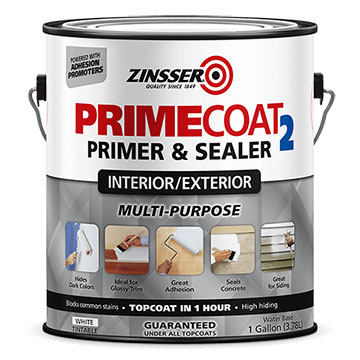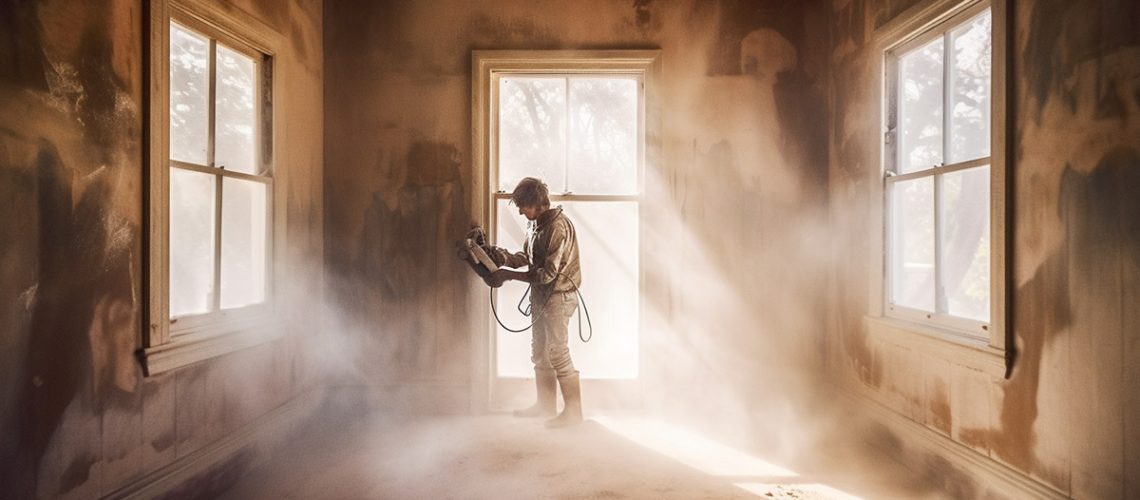Polyvinyl acetate (PVA) primer is the best sandable primer. It is designed to efficiently seal the pores of gyprock and is engineered to be sandable with sandpaper after being applied.
A perfect paint job starts with a solid foundation, and that’s where sandable primers come in. This article will guide you through the world of sandable primers, discussing the benefits, types, top choices, and application methods. By the end, you’ll not only know the best sandable primer for your project but understand what goes into making a great sandable primer.
What is a Sandable Primer?
A sandable primer is a specialised primer that can be easily sanded to create a smooth surface before applying paint or other finishes. A popular choice with professional residential painters, Sandable primers are designed to fill in minor imperfections and provide a uniform, even surface for subsequent coats.
According to Grand View Research, the global paints and coatings market size was valued at USD 146.17 billion in 2019 and is expected to grow at a compound annual growth rate (CAGR) of 4.3% from 2020 to 2027. The market is expected to be driven by the increasing product consumption in the construction, automotive, and general industries application sectors. Interestingly, a key driver of this growth is the construction industry, where primers are frequently used. The rapid urbanisation in emerging economies, such as China and India, is expected to spur construction activities, subsequently driving the demand for paints and coatings, including primers.
Benefits of Using a Sandable Primer
Smooth Finish
The primary benefit of using a sandable primer is the smooth finish it provides. Sanding the primer creates a level surface that ensures a more professional and appealing look when the topcoat is applied.
Adhesion Improvement
Sandable primers improve the adhesion of paint or other finishes to the surface. This reduces the likelihood of peeling or flaking, resulting in a longer-lasting and more durable finish.
Hiding Imperfections
A quality sandable primer can effectively hide minor imperfections, such as scratches or dents, on the surface. This results in a flawless finish, even on surfaces that have seen better days.
Long-lasting Results
By providing a stable foundation, sandable primers help extend the life of your paint job. This means less frequent repainting and lower maintenance costs in the long run.
Types of Sandable Primers
Oil-based Primers
Oil-based primers are known for their excellent adhesion and durability. They work well on various surfaces, including wood, metal, and masonry. However, they can take longer to dry and may emit strong fumes during application. For example, Benjamin Moore ADVANCE® Waterborne Interior Alkyd Primer is well-liked within the painting industry however it does take 24 hours to dry.
Water-based Primers
Water-based primers are easy to clean up and have low odour levels. They dry quickly and are suitable for use on drywall, plaster, and previously painted surfaces. While they offer good adhesion, they may not be the best choice for surfaces exposed to high levels of moisture or extreme temperatures.
Shellac-based Primers
Shellac-based primers offer excellent adhesion and stain-blocking capabilities, making them an ideal choice for surfaces with stubborn stains or odours. They dry quickly and can be used on a variety of materials, including wood, metal, and plaster. However, they can be more difficult to clean up and may emit strong odours during application.
Top 7 Sandable Primers
KILZ Original Multi-Surface Primer
KILZ Original is a versatile, oil-based primer that works well on a variety of surfaces, including wood, metal, and drywall. Just make sure the drywall is dry because dealing with wet drywall mud is tricky. It offers excellent adhesion and stain-blocking capabilities, making it ideal for projects requiring a high-quality finish.
Zinsser® B-I-N® Shellac-Base Primer
Zinsser® B-I-N® Shellac-Base Primer is a shellac-based formula known for its exceptional stain-blocking and adhesion properties. It’s an excellent choice for surfaces with difficult stains or odours, and it dries quickly, allowing for faster project completion.
Zinsser Primecoat2
Zinsser PrimeCoat2 is a multi-purpose, water-base primer and sealer for interior and exterior surfaces. It is great for drywall, wood, masonry, stucco and more. Zinsser PrimeCoat2 has a very low odour, making it ideal for interior work. It can be sprayed, brushed or rolled on. Its strong adhesion makes it ideal for exterior surfaces as well. Zinsser PrimeCoat2 dries fast and can be painted over in one hour.

Valspar Professional PVA Primer
Valspar’s Professional PVA Primer is a water-based option specifically designed for use on new drywall. It provides a smooth, even finish and promotes excellent adhesion for topcoats, making it a great choice for interior painting projects.
Dupli-Color® Sandable Primer
Dupli-Color’s Sandable Primer is another popular choice for automotive projects, offering excellent adhesion and a smooth surface for painting. It works well on metal surfaces and is easy to sand, ensuring a professional-looking finish.
FSC-88 WB HDU Primer (Water-Based)
The FSC 88 sandable water-based primer by Precision Board (Coastal Enterprises) is an exceptional product that provides outstanding sandability for surfaces with a texture similar to 150-grit or coarser. Specifically designed for use on cellular surfaces, this primer is perfect for projects where traditional sanding may prove difficult.
Within America, it is priced at $68 per gallon. The FSC 88 primer offers a three-coat application process that results in an ultra-smooth finish. Apply the first two coats at full strength without sanding in between, and then thin the final coat with water. Each coat should be applied when the previous one is dry to the touch.
Once the topcoat has dried completely, proceed with sanding. The three coats will bond together, creating a surface that may be smoother than necessary for optimal adhesion. To counteract this, you can lightly roughen the surface before applying the topcoat.
Ideal for exterior projects with minor imperfections or hard-to-sand areas, the FSC 88 primer is an excellent choice for tasks such as repainting old corbels. Its ability to feather out beautifully makes it a valuable addition to any painter’s toolkit, ensuring professional results every time.
Rust-Oleum Automotive Sandable Primer
Rust-Oleum’s Automotive Sandable Primer is a popular choice for automotive projects, providing excellent adhesion and a smooth finish. It works well on metal surfaces and dries quickly, allowing you to move on to the next step of your project with minimal downtime.
How to Choose the Best Sandable Primer
Surface Material
Consider the material you’re working with when selecting a sandable primer. Some primers are specifically designed for certain materials, while others are more versatile.
Drying Time
Drying time is an important factor to consider, as it can impact your project timeline. Some primers dry quickly, allowing you to move on to the next step sooner, while others require more time to cure properly.
Application Method
Consider the application method that best suits your needs. Some sandable primers can be applied with a brush or roller, while others require a sprayer for optimal results. As with all kinds of painting works, we recommend you use a washed drop cloth to protect surfaces.
Coverage Area
Consider the size of your project and the coverage area of the primer. Some primers offer better coverage per gallon, which can save you time and money on larger projects.
How to Apply a Sandable Primer
- Prepare the surface by cleaning it thoroughly and removing any loose paint, rust, or debris.
- Use a fine-grit sandpaper to lightly sand the surface, ensuring it’s smooth and free of imperfections.
- Apply the primer evenly, following the manufacturer’s instructions for the specific product and application method.
- Allow the primer to dry according to the recommended drying time on the label.
- Once dry, sand the primer using a fine-grit sandpaper until the surface is smooth and even.
- Wipe away any dust or debris, and proceed with applying your topcoat or finish.
Safety Precautions When Using Sandable Primers
- Wear protective gear, such as gloves and safety glasses, to protect your skin and eyes from contact with the primer.
- Ensure adequate ventilation when working with primers, particularly those with strong fumes, to minimize inhalation risks.
- Follow the manufacturer’s safety guidelines and warnings on the product label.
- Dispose of any unused primer and cleanup materials according to local regulations.
Conclusion
Selecting the best sandable primer for your project is essential for achieving a professional, flawless finish. By understanding the benefits, types, and application methods, you can make an informed decision and choose the right primer for your specific needs. Remember to follow safety precautions and guidelines to ensure a safe and successful project outcome.
FAQs
Can I use a sandable primer on any surface?
While sandable primers are versatile and can be used on a variety of surfaces, it’s essential to choose a primer specifically designed for the material you’re working with. Always consult the manufacturer’s guidelines for compatibility.
Do I always need to sand a sandable primer before applying the topcoat?
Sanding the primer before applying the topcoat is recommended for achieving the smoothest, most professional finish. However, some primers may not require sanding, so it’s essential to again follow the manufacturer’s instructions.
How many coats of sandable primer should I apply?
The number of coats required will depend on the specific primer and the surface you’re working with. Generally, one to two coats are sufficient, but you should always follow the manufacturer’s recommendations.
Do sandable primers have a shelf life?
Most primers do have a shelf life, which can vary depending on the product and storage conditions. To ensure the best performance, use the primer within its recommended shelf life and store it according to the manufacturer’s guidelines.

